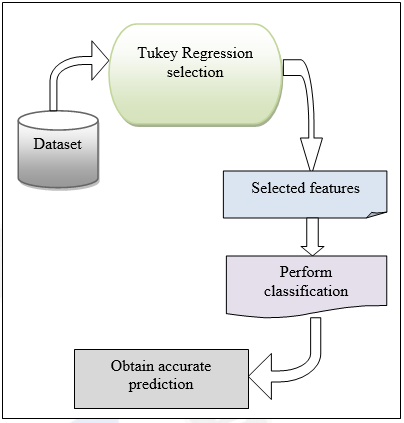Tukey Regressive Hoover Indexed Deep Shift-Invariant Neural Network for Student Behavior Prediction
Main Article Content
Abstract
Prediction of student performance in the academic field creates significant challenges in developing reliable and accurate diagnosis models. Through the use of online learning behavior data, this paper may assist teachers in identifying students with learning challenges in advance and providing timely assistance. A novel technique called Tukey Regressive Hoover indexed Deep Shift Invariant Structure Neural Network (TRHIDSISNN) Model is introduced for student behaviour analysis with lesser time consumption. Initially, the student data and features are collected and transmitted to the input layer. After that, the features of collected student data are analyzed in hidden layer 1 with help of the Tukey Regression. The correlation between one or more independent features is identified to find the dependent feature. The relevant features are sent to the hidden layer 2. In that layer, the Hoover index is applied for analyzing the training and testing features. Finally, the hidden layer result is sent to the output layer where the hyperbolic tangent activation function is used to classify the data that belongs to that particular class. Based on the classification, the student grade level is predicted as high, medium and low based on their behavior gets displayed. Experimental assessment is carried out using different parameters such as prediction accuracy, false-positive rate, prediction time, and space complexity with respect to the number of student data. The discussed results show that when compared to state-of-the-art approaches, the suggested TRHIDSISNN model achieves higher accuracy with shorter prediction times.
Article Details
References
F. Giannakas, C. Troussas, I. Voyiatzis, C. Sgouropoulou, “A deep learning classification framework for early prediction of team-based academic performance”, Applied Soft Computing, Elsevier, Vol. 106, pp.1-17, 2021
DiaaUliyan, AbdulazizSalamahAljaloud, Adel Alkhalil, Hanan Salem Al Amer, MagdyAbdElrhmanAbdallah Mohamed and AzizahFhad Mohammed Alogali, “Deep Learning Model to Predict Students Retention Using BLSTM and CRF”, IEEE Access, Vol. 9, pp.135550 – 135558, 2021
Xing Xua, JianzhongWanga, HaoPengd, RuilinWua, “Prediction of academic performance associated with internet usage behaviors using machine learning algorithms”, Computers in Human Behavior, Elsevier, Vol. 98, pp. 166-173, 2019
Hassan Zeineddine, UdoBraendle, Assaad Farah, “Enhancing prediction of student success: Automated machine learning approach”, Computers & Electrical Engineering, Vol.89, pp.1-22, 2021
Yeongwook Yang, DanialHooshyar, MargusPedaste, Minhong Wang, Yueh-Min Huang and Heuiseok Lim “Predicting course achievement of university students based on their procrastination behaviour on Moodle”, Soft Computing, Springer, pp.1-17, 2020
Ijaz Khan, Abdul Rahim Ahmad, NafaaJabeur and Mohammed Najah Mahdi, “An artificial intelligence approach to monitor student performance and devise preventive measures”, Smart Learning Environments, Springer, Vol. 8, pp.1-18, 2021
Aya Nabil, Mohammed Seyam, Ahmed Abou-Elfetouh, “Prediction of Students’ Academic Performance Based on Courses’ Grades Using Deep Neural Networks”, IEEE Access, Vol.9, pp.140731 – 140746, 2021
Kwok Tai Chui, Ryan Wen Liu, Mingbo Zhao, Patricia Ordóñez De Pablos, “Predicting Students’ Performance With School and Family Tutoring Using Generative Adversarial Network-Based Deep Support Vector Machine”, IEEE Access, Vol.8, pp. 86745 – 86752, 2020
Dong Liu, Yunping Zhang, Jun Zhang, Qinpeng Li, Congpin Zhang, Yu Yin, “Multiple Features Fusion Attention Mechanism Enhanced Deep Knowledge Tracing for Student Performance Prediction”, IEEE Access , Vol. 8, pp.194894 – 194903, 2020
HajraWaheed, Saeed-Ul Hassan, NaifRadiAljohani, Julie Hardman, Raheel Nawaz, “Predicting Academic Performance of Students from VLE Big Data using Deep Learning Models”, Computers in Human Behavior, Elsevier, Vol. 104, pp.1-34, 2020
Gabriela Czibulaa, Andrei Mihaia, Liana Maria Criveia, “S PRAR: A novel relational association rule mining classification model applied for academic performance prediction”, Procedia Computer Science, Elsevier, Vol.159, pp.20-29, 2019
AmmarAlmasri , ErbugCelebi, and Rami S. Alkhawaldeh, “EMT: Ensemble Meta-Based Tree Model for Predicting Student Performance”, Scientific Programming, Hindawi, Vol.2019, pp.1-13, 2019
Muhammad Imran, ShahzadLatif, Danish Mehmood, Muhammad Saqlain Shah, “Student Academic Performance Prediction using Supervised Learning Techniques”, International Journal of Emerging Technologies in Learning (iJET), Vol. 14, No. 14, pp.92-103, 2019
LipeDwan Pereira, Samuel C. Fonseca, Elaine H. T. Oliveira , Alexandra I. Cristea, HenrikBellhäuser ,Luiz Rodrigues, David B. F. Oliveira, Seiji Isotani, and Leandro S. G. Carvalho, “Explaining Individual and Collective Programming Students’ Behavior by Interpreting a Black-Box Predictive Model” IEEE Access ,Vol. 9, pp.117097 – 117119, 2021
Bashir Khan Yousafzai , SherAfzal Khan, TajRahman , Inayat Khan, InamUllah , Ateeq Ur Rehman,MohammedBaz , HabibHamam and Omar Cheikhrouhou, “Student-Performulator: Student Academic Performance Using Hybrid Deep Neural Network”, Sustainability, Vol. 13, pp.1-21, 2021
Maria Tsiakmaki, GeorgiosKostopoulos , Sotiris Kotsiantis and OmirosRagos, “Transfer Learning from Deep Neural Networks for Predicting Student Performance”, Applied Science, Vol. 10, pp.1-12, 2020
Anupam Khan, Soumya K. Ghosh, DurgadasGhosh, ShubhamChattopadhyay, “Random wheel: An algorithm for early classification of student performance with confidence”, Engineering Applications of Artificial Intelligence, Elsevier, Vol. 102, pp.1-15, 2021
Xuansheng Lu, Yanmin Zhu, YananXu, Jiadi Yu, “Learning from multiple dynamic graphs of student and course interactions for student grade predictions”, Neurocomputing , Elsevier,Volum 431 , 2021, Pages 23-33
YawenZeng, Yong Ouyang, RongGao, Ye Qiu, Yonghong Yu, Chunzhi Wang , “HHA: An Attentive Prediction Model for Academic Abnormality”, IEEE Access, Vol.8, pp.124755 – 124766, 2020
Xiaoyong Li, Yong Zhang, Huimin Cheng, Feifei Zhou, Baocai Yin, “An Unsupervised Ensemble Clustering Approach for the Analysis of Student Behavioral Patterns”, IEEE Access, Vol. 9, 7076 – 7091, 2021.

